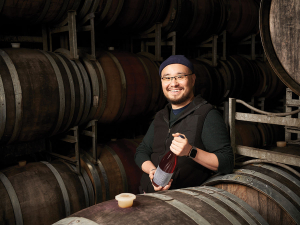Different winegrowing conditions and practices in three of New Zealand’s major Pinot Noir regions have been reflected in a chemical and sensory analysis of 116 wines from the 2020 vintage.
Dr Billy Yang, from the University of Auckland, is the lead author in the research, which provides insights into the chemical compositions, sensory profiles, commonalities and regional characteristics of New Zealand Pinot Noir wines.
Among the characteristics defined, Central Otago wines displayed unique monomeric anthocyanin profiles and were perceived as softer on the palate. Marlborough wines showed higher residual sugar but lower colour intensity and tannin concentration, while Martinborough wines “exhibited higher colour and robust mouthfeels, linked to higher colour absorbances, polymeric pigments, and tannins”.
The paper received a New Zealand Winegrowers Best Paper Award, sponsored by Bragato Research Institute, at this year’s New Zealand Wine Centre Scientific Research Conference. Billy’s PhD research fed into the four-year Pinot Noir Programme, which involved a small wine selection. He believes the comprehensive analysis of the latest research will provide a valuable and complementary addition to the findings of that major project.
Some of the 116 wines were made in a different place to the region they were grown in, such as a Marlborough Pinot Noir made in Central Otago, or vice versa. Further research, with more detailed sensory analysis, will add insights into whether those wines follow the typical traits found from wines in each region.
‘Inter-regional characterisation of New Zealand Pinot Noir wines: Correlation between wine colour, monomeric and polymeric phenolics, tannin composition, antioxidant capacity, and sensory attributes’, by Billy Yang, Zhijing Ye, Leandro Araujo, Tanya Rutan, Rebecca C. Deed and Paul A. Kilmartin, was published in Food Chemistry
sciencedirect.com/science/article/pii/S030881462403961X












